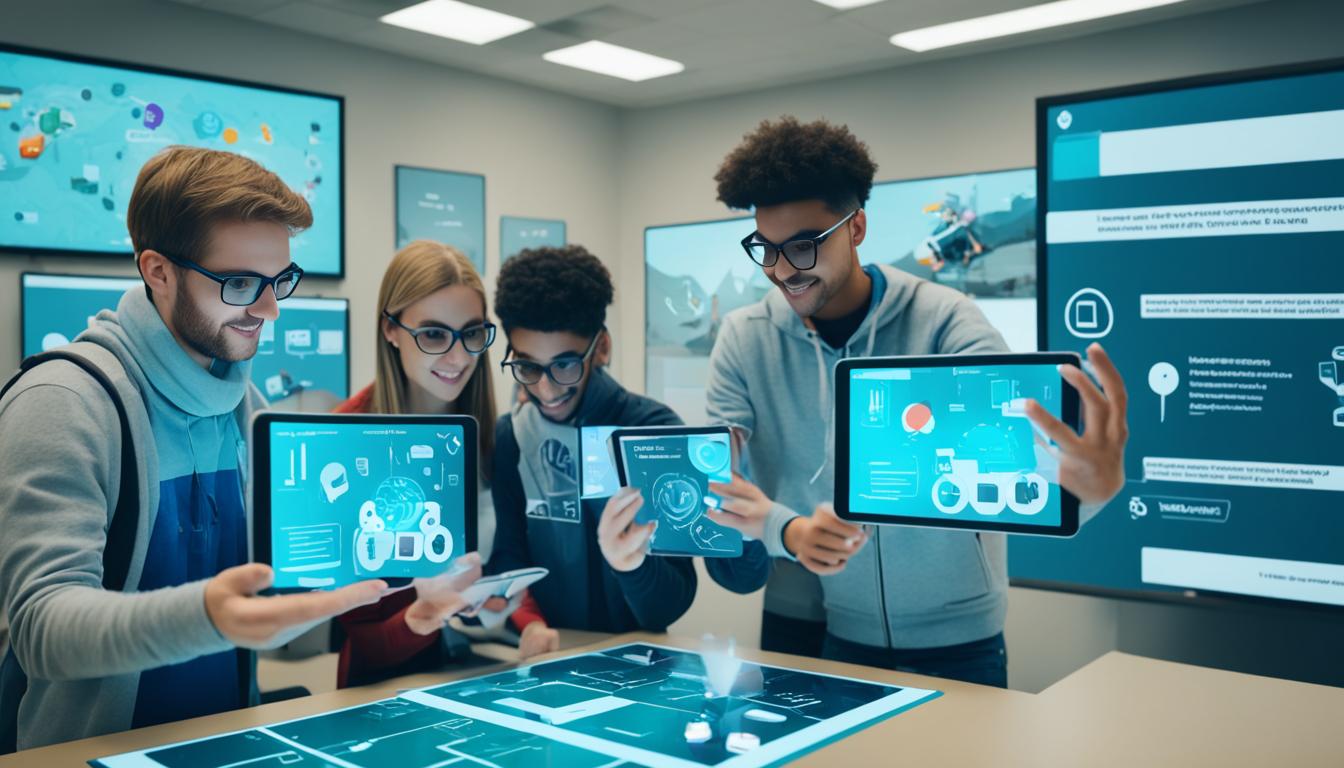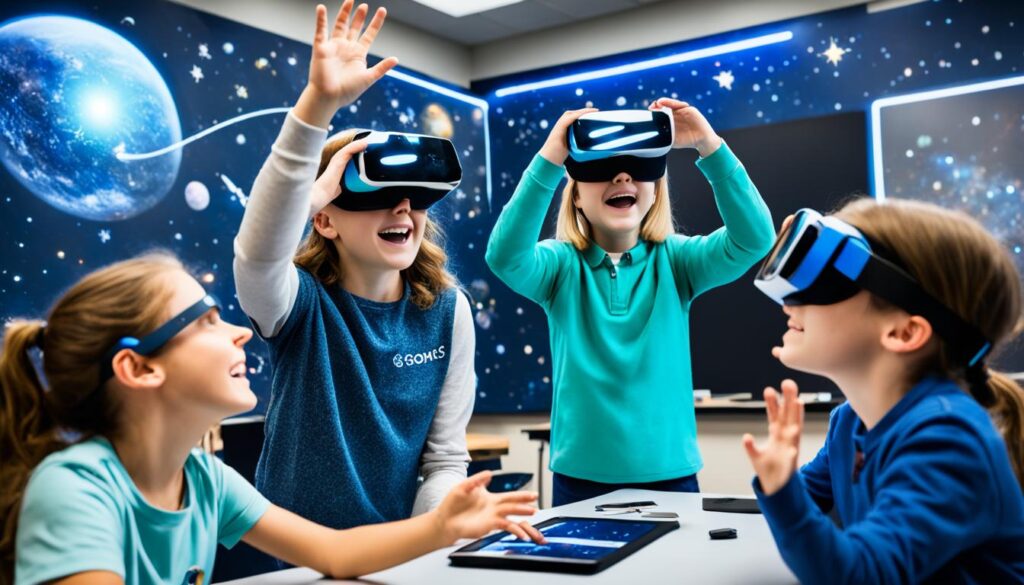The education world is changing fast, thanks to augmented reality (AR) technology. AR is making learning fun and interactive for students. By 2024, AR apps will change how we teach, making students understand better, remember more, and love learning.
This guide is all about making AR apps for education. It helps teachers, designers, and app makers create exciting learning experiences. You’ll learn about AR technology and how to make activities that make learning fun. This article is your guide to using AR in the classroom.
Table of Contents
Key Takeaways
- Discover the transformative potential of augmented reality in education
- Learn the core principles and benefits of implementing AR apps in the classroom
- Explore the essential steps for creating engaging and immersive AR learning experiences
- Understand the importance of aligning AR apps with curriculum goals and educational standards
- Gain insights into the best practices for seamlessly integrating AR into lesson plans
Augmented Reality: The Future of Education
Technology is changing education fast, and augmented reality (AR) is leading the way. It’s making learning exciting and interactive. AR brings complex ideas to life, making them fun and engaging for students of all ages.
Understanding the Power of AR in Classrooms
AR lets students interact with digital info right in the classroom. It mixes the virtual and real worlds together. This makes learning more fun and clear.
Students can see inside the human body or explore historical sites without leaving class. AR makes learning more exciting than just reading books or listening to lectures.
Benefits of Implementing AR in Educational Settings
- Improved student engagement and motivation
- Enhanced visualization and understanding of abstract concepts
- Personalized learning experiences tailored to individual needs
- Increased knowledge retention and better learning outcomes
- Seamless integration of hands-on, interactive learning activities
AR is changing education for the better. It turns learning into an active, immersive experience. As teachers use this new tech, education will become more engaging and open to everyone.
Creating Augmented Reality Apps for Education
Creating AR apps for education is a new way to make learning fun. It combines digital content with the real world. This makes learning more engaging and memorable for students. To make these apps, we need to think about how the technology works and match it with what students need to learn.
First, we must understand what teachers and students need. They want tools that make learning fun and interactive. AR apps can do this by offering a dynamic and visually appealing way to learn.
- Identify the learning objectives and curriculum standards that the AR app aims to address.
- Conduct thorough research on the target audience, their learning needs, and the educational context.
- Explore the affordances of AR technology and how it can be leveraged to enhance the learning experience.
- Collaborate with subject matter experts, instructional designers, and education specialists to ensure the content and interactions align with pedagogical best practices.
Creating AR apps also means focusing on how easy and fun they are to use. The app should be easy for students of all backgrounds and abilities. Using universal design and accessibility features makes learning better for everyone.
| Key Considerations in Creating Educational AR Apps | Explanation |
|---|---|
| Pedagogical Alignment | Ensuring the AR content and interactions support specific learning objectives and curriculum standards. |
| User-Centered Design | Prioritizing the needs and preferences of the target audience, including students and educators. |
| Technological Capabilities | Leveraging the unique capabilities of AR technology to create immersive and engaging learning experiences. |
| Iterative Development | Incorporating user feedback and testing throughout the development process to refine and optimize the AR app. |
By thinking about these important points, developers and teachers can make AR apps that improve learning. These apps can engage students and help them understand complex ideas better. As technology in education grows, AR will change how students learn and interact with the world.
Choosing the Right AR Development Platform
The demand for educational AR apps is growing fast. It’s key to pick the right AR development platform for engaging learning experiences. These platforms offer many features and capabilities. It’s important to find one that fits your needs and goals.
Popular AR Development Platforms for Educational Apps
Several AR development platforms lead the way in creating educational AR apps. They have tools, features, and options for integration. This helps educators and app developers make learning immersive.
- Unity: A widely-adopted game engine that provides a comprehensive set of tools for building AR applications, including support for multiple AR frameworks like ARKit and ARCore.
- Unreal Engine: A powerful game engine that has gained traction in the AR development space, offering advanced graphics rendering and a user-friendly interface for creating AR experiences.
- ARKit (iOS) and ARCore (Android): Native AR development platforms provided by Apple and Google, respectively, allowing developers to create AR applications tailored for specific operating systems.
- Vuforia: A robust AR development platform that simplifies the creation of AR apps by providing features like image recognition, object tracking, and cloud-based services.
- Lens Studio: Developed by Snap Inc., Lens Studio enables the creation of AR experiences for Snapchat, making it a popular choice for developing educational AR filters and lenses.
| AR Development Platform | Key Features | Supported Devices | Suitable for Educational Apps |
|---|---|---|---|
| Unity | Comprehensive game engine, cross-platform support, advanced graphics | iOS, Android, Windows, macOS | Yes, highly versatile for creating immersive AR experiences |
| Unreal Engine | Powerful graphics rendering, user-friendly interface, advanced features | iOS, Android, Windows, macOS | Yes, particularly suitable for creating visually stunning AR apps |
| ARKit (iOS) and ARCore (Android) | Native AR development platforms, integrated with respective OS, robust tracking | iOS, Android | Yes, optimized for creating platform-specific AR experiences |
| Vuforia | Simplified AR development, advanced tracking capabilities, cloud services | iOS, Android, Windows | Yes, suitable for developing educational AR apps with various tracking features |
| Lens Studio | Designed for Snapchat AR, easy-to-use interface, cloud-based platform | iOS, Android | Yes, ideal for creating AR filters and lenses for educational purposes |
When picking an AR development platform for educational apps, think about device compatibility, customization needs, AR feature complexity, and costs. By looking at these factors, you can find the best platform. This will help you create engaging and effective learning experiences for your students.
Designing Engaging and Immersive AR Experiences
The way we teach is changing, and augmented reality (AR) experiences are now key for educators and designers. Making AR apps that grab students’ attention can make learning more fun and effective. Let’s look at what makes AR experiences for education engaging.
Good AR design starts with knowing who will use it – the students. It’s important to make the app easy to use and fun. This way, students can dive into the AR experiences without trouble, which helps them remember what they learn better.
Using interactive 3D models and virtual simulations makes hard topics easy to understand. Students can see and touch these models in real-time. This makes learning more exciting and helps them get really interested in the subject.
“AR has the potential to transform the way we teach and learn, by creating engaging, interactive experiences that captivate students and deepen their understanding of the material.”
Adding gamification elements can make AR educational apps even better. Challenges, rewards, and a sense of progress make learning fun and motivating for students.
By focusing on what students need and using augmented reality well, we can make learning experiences that inspire and empower students. These experiences help students explore, discover, and do well in the future classroom.
Incorporating Gamification Elements
AR apps for education use gamification to make learning fun. They mix AR’s immersive tech with game-like features. This makes learning not just fun but also helps students understand better.
Enhancing Learning Through Gamified AR Experiences
AR apps add fun to learning with challenges, rewards, and leaderboards. These elements use our desire for progress and recognition to keep students interested in learning.
- Challenges and Quests: AR apps give students challenges that make them use what they’ve learned. This helps them understand better.
- Rewards and Badges: Students get virtual rewards for doing well or showing they know a lot. This makes them feel good and want to keep using the app.
- Leaderboards and Competitive Elements: Adding competition, like leaderboards, makes students want to do their best. It helps them learn more.
AR’s interactive nature and gamification make learning more fun and effective. This leads to better retention of knowledge and a deeper understanding of the subject.
Augmented reality frameworks help developers add gamification easily to their AR apps. This makes creating engaging and empowering learning experiences simpler.
“Gamification in AR-powered educational apps taps into the natural human desire for progression, mastery, and social recognition, motivating students to actively participate in the learning process.”
Aligning AR Apps with Curriculum Goals
Teachers are looking into AR apps to see how they can help in the classroom. It’s key that these apps match up with curriculum goals and educational standards. AR should fit into lesson plans and help students learn, not get in the way.
Mapping AR Experiences to Educational Standards
Creating AR apps for schools means checking them against educational standards that fit the subject and grade level. This makes sure the AR is not just fun but also teaches important stuff. By linking AR to specific learning goals, teachers can make sure the tech really helps students and tracks their progress.
| Educational Standard | AR App Alignment |
|---|---|
| Understand the properties of matter and the changes it undergoes | An AR app that allows students to visualize and interact with the molecular structure of different materials, explore phase changes, and observe chemical reactions |
| Analyze and interpret data to determine the factors that affect the speed of sound | An AR simulation that enables students to manipulate variables such as temperature, pressure, and medium to observe their impact on the propagation of sound waves |
| Describe the characteristics of different ecosystems and the relationships between their biotic and abiotic components | An AR-powered virtual field trip that immerses students in various ecosystems, allowing them to observe and interact with the flora, fauna, and environmental factors |
By matching AR apps with curriculum goals and educational standards, teachers can make learning fun and meaningful. This helps students understand better and do well.
User Testing and Iterative Development
Creating effective augmented reality (AR) apps for education needs an ongoing process. This process focuses on getting feedback from users. By listening to students, teachers, and others, developers can make their AR experiences better.
The secret to making AR learning tools engaging is a cycle of testing and improving. This cycle lets developers make the user experience better, improve gameplay, and make content more engaging. It also ensures the app runs smoothly.
Adding user testing early in the AR app development process helps spot problems and understand what users want. This way, developers can fix issues before the app comes out. It also builds a community around the AR experience, making sure the app delights its users.
“User feedback is crucial in shaping the future of AR in education. By listening to the needs and preferences of students and teachers, we can create truly transformative learning experiences.”
By using an iterative process and focusing on user testing, developers can make AR apps that improve learning and make it fun. This approach lets AR technology fully change how students learn and interact with educational content.
Accessibility and Inclusive Design Considerations
AR technologies are changing education in big ways. It’s key to make sure everyone can use these new tools. Making AR apps accessible for people with disabilities is a must. This ensures everyone gets the same chance to learn and grow.
Making AR Apps Accessible to All Learners
Creating inclusive AR apps means thinking about everyone’s needs. This means adding things like text-to-speech, high-contrast modes, and working with assistive tech. By doing this, all students can fully enjoy and benefit from AR.
| Accessibility Feature | Benefit |
|---|---|
| Text-to-Speech | Helps users with visual impairments or reading challenges |
| High-Contrast Modes | Makes it easier for people with low vision or color blindness to see |
| Compatibility with Assistive Technologies | Works well with screen readers, haptic devices, and other tools |
By focusing on accessibility and inclusive design, developers can make AR apps for everyone. This makes sure education is fair and rewarding for all.
“Inclusive design is not only the right thing to do, but it also leads to better products that are usable by a wider range of people.”
Privacy and Security Concerns
As more augmented reality (AR) apps are used in schools, keeping privacy and security top of mind is key. Student data is very important and must be kept safe. This is crucial for teachers, parents, and those who make policies.
Safeguarding Student Data in AR Apps
Creating AR apps for learning needs a strong focus on data privacy and security. Teachers and app makers must follow strict rules to protect student info. This includes the Family Educational Rights and Privacy Act (FERPA) in the U.S.
- Use strong data encryption and controls to keep student data safe from unauthorized access.
- Be open about how data is collected and used, with clear rules and consent for students and parents.
- Keep security measures up to date to meet new threats and tech changes.
- Teach educators and students how to handle data responsibly and follow privacy guidelines.
By focusing on privacy and security in AR apps, teachers can make learning fun and keep student data safe. This builds trust and safety for everyone.
“Keeping student privacy safe is not just a legal thing, but a moral one in today’s digital world. Using augmented reality in schools must be with strong data security steps.”
Deployment and Distribution Strategies
The use of AR app deployment in schools is growing fast. It’s important to know how to make it work well in schools. This means looking at the school’s tech setup, making sure devices work right, and finding easy ways to share the apps with everyone.
It’s important to make sure AR apps fit with what the school already uses. This might mean linking them to the school’s system, following device rules, and using the network well. This way, teachers can easily start using AR in class and get the most out of it.
Getting AR apps to teachers and students should be easy. You can use app stores, special platforms for schools, or even put them online. Giving clear help and resources can make it easier for everyone to use these new AR education tools.
To make AR apps work well in schools, you need a complete plan. Think about what schools need and how they work. This way, schools can really benefit from augmented reality and make learning more exciting and effective.
“The integration of augmented reality in education has the power to revolutionize the way we approach learning and teaching.” – Dr. Jane Doe, Educational Technology Expert
Measuring the Impact of AR on Learning Outcomes
Augmented reality (AR) is changing how we teach and learn. It’s important to see how AR affects students’ learning. We need a strong way to check how well AR works in schools.
To see how AR helps students, we must look at the data. This includes checking how engaged students are, how much they remember, and if they meet learning goals. This helps us understand what works and what doesn’t with AR in learning.
Quantifying the AR Impact
Measuring AR’s effect on learning is best done with both numbers and stories. This means:
- Testing students before and after to see what they know
- Asking students and teachers what they think
- Watching how students act in class with AR
- Looking at their work and projects
By using all these ways to gather data, we can really understand how AR changes learning. This helps us see the AR impact on learning outcomes and assessment.
| Metric | Description | Example Data |
|---|---|---|
| Knowledge Retention | How well students remember what they learned with AR |
|
| Engagement and Motivation | How interested and motivated students are with AR learning |
|
| Skill Development | How well students get and use skills like problem-solving with AR |
|
By carefully tracking these areas, we can learn a lot about how AR affects learning. This helps us make better choices for the future of teaching with AR.
“Augmented reality has the potential to change education. But we must measure its impact to make sure it really helps students learn.”
Best Practices for Implementing AR in the Classroom
Augmented reality (AR) is becoming a key tool in education. Teachers need to know how to use AR well in their lessons. This helps make learning more engaging and effective.
Tips for Seamless Integration of AR into Lessons
Adding AR to the classroom needs careful planning. Here are some tips for a smooth AR integration:
- Align AR applications with specific learning objectives: Pick AR apps that help meet your lesson goals.
- Provide comprehensive training for teachers: Make sure teachers know how to use AR with help and support.
- Incorporate AR as a complementary tool, not a replacement: Use AR to make learning better, not just to teach.
- Facilitate active engagement and collaboration: Design AR activities that get students working together and exploring.
- Continuously assess and refine the AR implementation: Check how well AR is working, ask students what they think, and make changes as needed.
By using these tips, teachers can easily add AR implementation to their classroom and lesson integration. This lets students learn in new and exciting ways.
“Augmented reality has the potential to transform the way we teach and learn, bringing abstract concepts to life and fostering a deeper understanding of the world around us.”
Future Trends in AR for Education
Augmented reality technology is getting better, making the future of AR in education bright. New AR hardware, AI-powered content, and combining AR with other immersive tech are changing how students learn. They’re making education more engaging and interactive.
Emerging Technologies Shaping the AR Landscape
AR hardware is getting better, with lighter and more comfortable headsets. Soon, AR will be on smartphones and tablets too, making it easier for everyone to use. AI will also help create AR content that fits each student’s learning style.
AR is also teaming up with VR and MR, creating deeper learning experiences. This mix will let students dive into educational content in new, exciting ways. It’s changing how we see learning and exploration.














